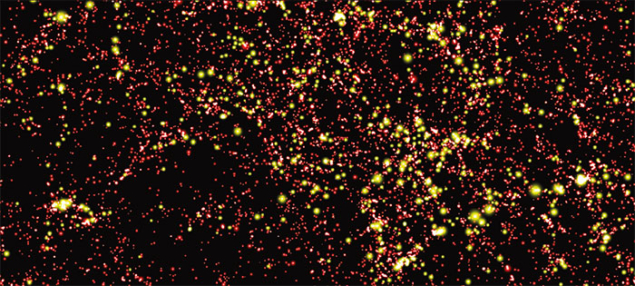The latest cosmic-ray data from AMS have implications for particle-physics models of dark matter and other novel phenomena.

Image credit: Virgo consortium/A Amblard/ESA.
In the first half of the 20th century, many of the most important discoveries of new particles were made by cosmic-ray experiments. Examples include antimatter, the muon, pion, kaon and other hadrons, which opened up the field of high-energy physics and set in motion our modern understanding of elementary particles. This came about because cosmic-ray interactions with nuclei in the upper atmosphere are among the highest-energy events known, surpassing anything that could be produced in laboratories at the time – and even in collisions at the LHC today.
However, around the middle of the century the balance of power in particle physics shifted to accelerator experiments. By generating high-energy interactions in the laboratory under controlled conditions, accelerators offered new possibilities for precise measurements and thus for the study of rare particles and phenomena. These experiments helped to flush out the quark model and also the fundamental force-carrying bosons, leading to the establishment of the Standard Model (SM) – whose success was crowned by the discovery of the Higgs boson at the LHC in 2012.
Today, thanks to its unique position on the International Space Station, the AMS experiment combines the best of both worlds as a highly sensitive particle detector that is free from the complicated environment of the atmosphere (see “Cosmic rays continue to confound“). Collecting data since 2011, AMS has initiated a new epoch of precision cosmic-ray experiments that help to address basic puzzles in particle physics such as the nature of dark matter. The experiment’s latest round of data continues to throw up surprises. Arriving at the correct interpretation of events due to particles produced far away in the universe, however, still presents challenges for physicists trying to understand dark matter and the cosmological asymmetry between matter and antimatter.
Best of both worlds
The emphasis in particle physics now is on the search for physics beyond the SM, for which many motivations come from astrophysics and cosmology. Examples include dark matter, which contributes many times more to the overall density of matter in the universe than does the conventional matter described by the SM, and the origin of matter itself. Many physicists think that dark matter may be composed of particles that could be detected at the LHC, or might reveal themselves in astrophysical experiments such as AMS. As for the origin of matter, the big question has been whether it is due to an intrinsic difference between the properties of matter and antimatter particles, or whether the dominance of matter over antimatter in the universe around us is merely a local phenomenon. Although it is unlikely that there exist other regions of the observable universe where antimatter dominates, there is limited direct experimental evidence against it.
The AMS approach to cosmic-ray physics is based on decades of experience in high-statistics, high-precision accelerator experiments. It has a strong focus on measurements of antiparticle spectra that allows it to search indirectly for possible dark-matter particles, which would produce antiparticles if they annihilated with each other, as well as for possible harbingers of astrophysical concentrations of antimatter. In parallel, AMS is able to make measurements of the energy spectra of many different nuclear species, posing challenges for models of the origin of cosmic rays – a mystery that has stood ever since their discovery in 1912.
Unconventional physics?
The latest AMS results on the cosmic-ray electron and positron fluxes provide very accurate measurements of the very different spectra of these particles. Numerous previous experiments had discovered an increase in the positron-to-electron ratio at increasing energies, although with considerable scatter. AMS has now confirmed this trend with greater precision, but it also indicates that the positron-to-electron ratio may decrease again at energies above about 300 GeV. The differences between the electron and positron fluxes mean that different mechanisms must be dominating their production. The natural question is whether some exotic mechanism is contributing to positron production.

One possibility is the annihilation of dark-matter particles, but a more conventional possibility is production by electromagnetic processes around one or more nearby pulsars. In both cases, one might expect the positron spectrum to turn down at higher energies, being constrained by either the mass of the dark-matter particle or by the strength of the acceleration mechanism around the pulsar(s). In the latter case, one would also expect the positron flux to be non-isotropic, but no significant effect has been seen so far. It will be interesting to see whether the high-energy decrease in the positron-to-electron ratio is confirmed by future AMS data, and whether this can be used to discriminate between exotic and conventional models for positron production.
A more sensitive probe of unconventional physics could be provided by the AMS measurement of the spectrum of antiprotons. These cannot be produced in the electromagnetic processes around pulsars, but would be produced as “secondaries” in the collisions between primary-matter cosmic rays and ordinary-matter particles. It is striking, for instance, that the antiproton-to-proton ratio measured by AMS is almost constant at energies of about 10 GeV. The ratio is significantly higher than some earlier calculations of secondary antiproton production, although recent calculations (which account more completely for the theoretical uncertainties) indicate that the antiproton-to-proton ratio may be somewhat higher – possibly even consistent with the AMS measurements. As with the case for positron production, extending the measurements to higher energies will be crucial for distinguishing between exotic and conventional mechanisms for antiproton production.
AMS has also released interesting data concerning the fluxes of protons, helium and lithium nuclei. Intriguingly, all three spectra show strong indications of breaks in the spectra at rigidities of around 200 GV. The higher-energy portions of the spectra lie significantly above simple power-law extrapolations of the lower-energy data. It seems that some additional acceleration mechanism might be playing a role at higher energies, providing food-for-thought for astrophysical models of cosmic-ray acceleration. In particular, the unexpected shape of the spectrum of primary protons in the cosmic rays may also need to be taken into account when calculating the secondary antiproton spectrum.
The AMS data on the boron-to-carbon ratio also provide interesting information for models of the propagation of cosmic rays. In the most general picture, cosmic rays can be considered as a relativistic gas diffusing through a magnetised plasma. This leads to a boron-to-carbon ratio that decreases as a power, Δ, of the rigidity, with different models yielding values of Δ between –1/2 and –1/3. The latest AMS data constrain this power law with very high precision: Δ = –0.333±0.015, in excellent agreement with the simplest Kolmogorov model of diffusion.
The AMS collaboration has already collected data on the production of many heavier nuclei, and it would be interesting if the team could extract information about unstable nuclear isotopes that might have been produced by a recent nearby supernova explosion. Such events might already have had an effect on Earth: analyses of deep-ocean sediments have recently confirmed previous reports of a layer of iron-60 that was presumably deposited by a supernova explosion within about 100 parsecs about 2.5 million years ago, and there is evidence of iron-60 also in lunar rock samples and cosmic rays. Other unstable isotopes of potential interest include beryllium-10, aluminium-26, chlorine-39, manganese-53 and nickel-59.
Promising prospects
What else may we expect from AMS in the future? The prospective gains from measuring the spectra of positrons and antiprotons to higher energies have already been mentioned. Since these antiparticles can also be produced by other processes, such as pulsars and primary-matter cosmic rays, they may not provide smoking guns for antimatter production via dark-matter annihilation, or for concentrations of antimatter in the universe. However, searches for antinuclei in cosmic rays present interesting prospects in either or both of these directions. The production of antideuterons in dark-matter annihilations may be visible above the background of secondary production by primary-matter cosmic rays, for example. On the other hand, the production of heavier antinuclei in both dark-matter annihilations and cosmic-ray collisions is expected to be very small. The search for such antinuclei has always been one of the main scientific objectives of AMS, and the community looks forward to hearing whatever data they may acquire on their possible (non-)appearance.
As this brief survey has indicated, AMS has already provided much information of great interest for particle physicists studying scenarios for dark matter, for astrophysicists and for the cosmic-ray community. Moreover, there are good prospects for further qualitative advances in future years of data-taking. The success of AMS is another example of the fruitful marriage of particle physics and astrophysics, in this case via the deployment in space of a state-of-the-art particle spectrometer. We look forward to seeing the future progeny of this happy marriage.





